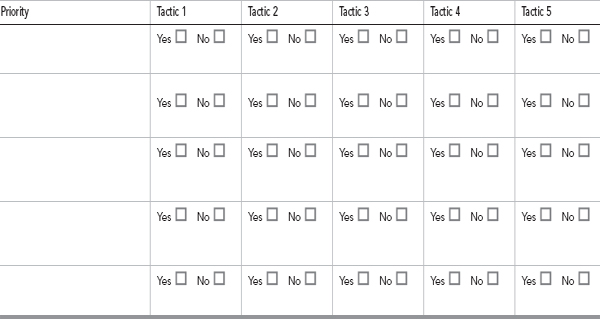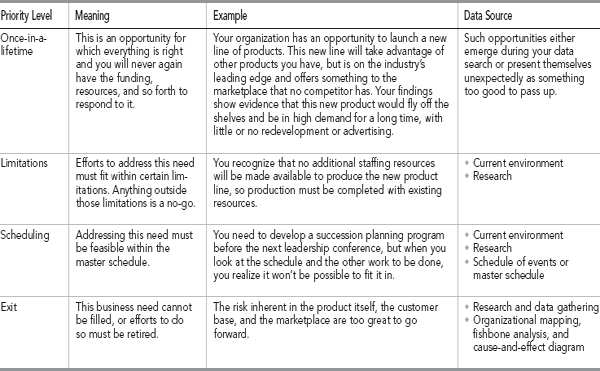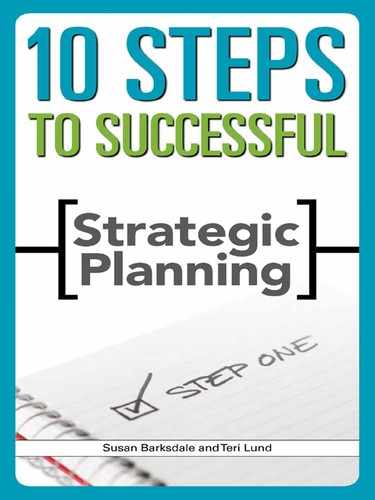STEP SIX
Prioritizing Needs and Identifying Risks
OVERVIEW
Setting criteria for prioritizing business needs
Ranking the organization's priorities
Identifying and managing business risks
Creating a decision matrix
The work you've done to scan the business environment, identify business drivers, and articulate or reconfirm the organization's mission, vision, and values has brought you to this point. You should have a clear picture of your organization's tolerance for change and risk and of the unstated rules that affect the organization's politics, decision making, and commitments or sign-offs. You also should have a better understanding of the marketplace in which your organization does business and of the challenges facing it daily. Your mission statement and objectives establish where the organization stands and what it provides to its customers and employees. All of this knowledge is helpful in arranging business needs in their order of descending importance (Step 6) and making decisions about what tactics to pursue for your strategic plan (Step 7).
In any organization, every strategy has resource limitations. There is a finite number of projects and initiatives in which an organization can be involved at any given time, and some are simply more important than others. We all have parameters within which we must work (resources, organizational culture, deadlines, or other constraining factors), and we have to take those parameters into account when we set our priorities so that our expenditures of resources and effort yield the value we advertise.
POINTER
Regardless of the organization, every strategy has resource limitations. There are only so many projects and initiatives in which an organization can be involved at any given time, and some are simply more important than others.
In Step 6 of 10 Steps to Successful Strategic Planning, you create criteria for rank-ordering the needs, or priorities, of your business, and this ordering ultimately helps you make decisions about your tactics. These criteria will help you decide (1) which opportunities you should pursue and which gaps you should fill without delay and (2) which you should table for the time being. By revealing what is most important to the organization, the criteria point you toward the tactics that will deliver the most bang for the buck. These criteria will accelerate the development of your tactics in Step 7 and will be valuable tools when you start to execute your strategic plan because they guide your decisions about change.
In this step we'll discuss the following topics:
![]() establishing criteria to prioritize business needs
establishing criteria to prioritize business needs
![]() ranking priorities
ranking priorities
![]() identifying and managing risks.
identifying and managing risks.
First, let's set the scene with a case example.
Case Example: Prioritizing Needs
This example illustrates how an organization rank-ordered its business needs to help it choose tactics and garner resources.
Setting Priorities for Filling Gaps
Investments Group (IG) is a large, private company that manages various investment funds. Although the organization is rather conservative, it has always funded its various business units very well. In the past three years, IG has acquired several other companies and funds, and is now seen as a global investment management company. With this growth, the organization has found its responsibilities changing and expanding.
While developing its strategy going forward, IG found 10 critical performance gaps that needed attention within the next year. Without discontinuing many of the current programs or greatly enlarging its staff, however, IG probably cannot address all of the gaps within 12 months.
The strategy group discussed the organization's business needs and evaluated them against the mission, vision, and values. This priority setting helped prompt a useful discussion of the trade-offs that management would be willing to accept, with certain provisions, including merging some of the offshore staffing into corporate positions so there would be more flexibility in job assignments. This preparation saved the group time later on as it created its strategic plan and negotiated the resources to implement it.
Establishing Criteria for Setting Priorities
Establishing the priority-setting criteria before you develop the tactics for the strategic plan helps ensure that the tactics will align with the organization's business needs and culture. In later steps you'll use your criteria to validate your tactics and explain the sequence of decisions you made when choosing tactics.
The organizational mapping and business driver identification you completed in Step 2 should have given you an understanding of the values and priorities of the organization, its management, and others closely associated with it. For example, if your organization's marketplace is highly competitive, then initiatives that provide competitive advantage will be most important. However, if your organization has experienced a great deal of turnover and the associated turmoil and costs, retention strategies may have priority.
The mission, vision, and values that have been defined further delineate who the organization is, why it exists, and, most important, what it considers valuable behaviors and actions.
Worksheet 6.1 can help your group identify the organization's principal priorities. Part A lists various priorities that typically compete for resources and effort. From that list, choose five to seven items that you believe would receive the most support and commitment from your customers, stakeholders, business partners, and sponsors. From that assemblage, choose the three to five priorities that bear the greatest importance, and write those in the first column of part B. As you create your action plans in Step 7, use part B to examine how proposed tactics fit the organization's top priorities and choose those you believe are most viable.
Ranking Priorities
You can rank your business needs (and therefore your choice of tactics in Step 7) using the following criteria:
1. Once-in-a-lifetime opportunity: This need should be addressed at all costs.
2. Limitations: This need is seen as a high priority, but it has limitations (such as budget, resources, risk level, and timeframe).
3. Scheduling: This need is important only if it is addressed within a specific timeframe.
4. Exit: Results of efforts to address this need are not worth the time and resources they would require.
After you select your principal business needs using worksheet 6.1, use the criteria listed above and described more fully in table 6.1 to rank their importance and feasibility.
Identifying and Managing Risks
Risk is a reality in all organizations, and certainly in strategic planning. Each time you recognize a business need, assign it a priority for planning, and begin to consider tactics to address it, you'll encounter some degree of risk posed by the suggested tactics. The degree will vary from need to need. Some risks are potentially more costly than others, and some are easier to manage. The marketplace your organization competes in may be a source of risk, or technological change may be a source. Risk is simply a part of our lives, and it's important to recognize that any overall strategy will have to include risk-mitigation efforts. Identifying how to manage the inherent risks in your strategy is important to ensure that your mission statement and objectives are fulfilled.
WORKSHEET 6.1
Selecting the Organization's Top Priorities
Part B: Examining the Fit between Priorities and Tactics
Instructions: In the first column, list the three to five priorities from the list above that you believe are most important to your organization. Then complete this section after developing your tactics in Step 7.

TABLE 6.1
Criteria for Ranking Priorities

POINTER
Identifying how to manage the risk inherent in your strategy is important, and it will ensure that your mission statement and objectives are fulfilled.
Worksheet 6.2 is a risk assessment tool. The statements in the worksheet are based on issues we've encountered in real-life strategic plans. These issues created chaos or delays that almost shelved the strategic planning process. When you've identified which risks your organization faces and how great a level of risk each one poses, note those that are potentially most costly (those rated 3) and then decide how to handle them. You'll need a risk management strategy for each of them. In addition, you should identify any interdependencies or relationships that exist among the statements you rated 3. Usually, the more interdependencies or relationships, the greater the risk to the success of your plan.
Let's consider an example. If you rated the following statements with a 3, it would be important to look at the relationships among them because of the possibility of greater risk. Here are the statements:
![]() The organization must introduce new technology.
The organization must introduce new technology.
![]() Implementing additional efforts will push our capacity, and we will not have the resource allocations needed to handle our current work without compromising quality.
Implementing additional efforts will push our capacity, and we will not have the resource allocations needed to handle our current work without compromising quality.
![]() A similar strategy was launched in the past, and it failed.
A similar strategy was launched in the past, and it failed.
WORKSHEET 6.2
Assessing Organizational Risks
In this example, you have new technology, you don't have the resources to handle the new technology, and a similar strategy already has failed. If you decide to go forward with efforts to address this business need, your stakeholders and managers must be made aware of these related risk factors, and you have to formulate a plan to mitigate the risk.
Worksheet 6.3 is a risk matrix in which you record the risks, suggest actions to mitigate them, and note all other related risks that must be considered. Having this well-rounded view of each risk helps you identify the organizational significance of the risk.
WORKSHEET 6.3
Risk Matrix
| Instructions: In column 1, record the areas of highest risk to the organization. Suggest actions to counter those risks in column 2, and note ways in which one risk is related to another risk in column 3. Two illustrative entries are provided. | ||
| Area of High Risk | Actions to Control Risk | Related or Interdependent Risks |
| The strategy has high political visibility. | We will develop a strong, viable communication plan that is horizontal and vertical. | Shareholders or senior managers expect specific outcomes. |
| Employee morale is at stake in the way they view their jobs, the company, and our business. Our strategy must address this. | |
|
Creating a Decision Matrix
If you've encountered any resistance to your strategic planning efforts, be sure you complete all the worksheets presented thus far in Step 6. This thorough examination will ensure the business needs, priorities, and risks are addressed in the tactics you will develop in Step 7.
The decision matrix provided in worksheet 6.4 lists statements that can help you prioritize your business needs. You can use the matrix as a shortcut to setting the priority of various business needs if you have strong commitment to proceed from the strategic planning work group, senior managers, and executives; if the mission, vision, and values have been agreed to; and if there is commitment to the defined outcomes. The business priorities with the highest scores on the matrix are those that are most likely to fit in your organization, make an impact, and be successful.
WORKSHEET 6.4
Decision Matrix for Business Needs
![]()
To this point, you've laid a solid foundation for your strategic plan. In the next two steps, you'll take the information, ideas, beliefs, and dreams you've identified and transform them into a realistic plan for the organization's future.
